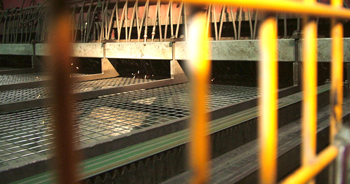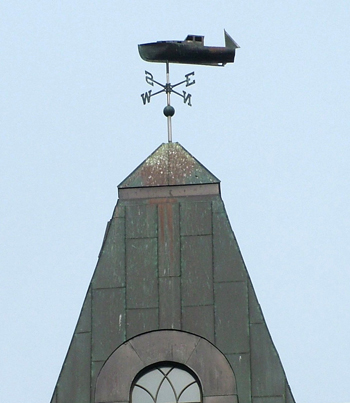Riverdale Mills Celebrates
35th Anniversary

Custom built trap wire welding machine at Riverdale Mills. Riverdale Mills’ specially-formulated steel wire is precision welded simultaneously across each wire over the whole width of a section. From this station the welded wire goes to the galvanizing department. The company’s proprietary powder coat is the last step. Fishermen’s Voice photo
The wooden lobster trap today has all but disappeared except for decorating seafood restaurants. But not long ago, it was as omnipresent as the wire lobster trap is today. The shift from wood to wire can be traced back to a precise point in time. That point was when Jim Knott Sr. got a patent on a coated wire lobster trap in the 1960s. Before starting Riverdale Mills in Northbridge, Massachusetts, to manufacture the wire needed to build wire traps, Knott ran a plastic coating company. His experience in coatings was linked at some point with time spent as a boy fishing lobster out of a skiff in Gloucester. The first trap was built and then coated. It was the first of its kind for many years.
Jim Knott Jr. worked closely with his father from 1979 to 1997 building Riverdale Mills into the leading producer of coated wire products. He came back to the company and is now the company’s CEO. Riverdale has a 70% share of the North American lobster trap wire market. The other 30% is shared by China and Italy. “Riverdale is in the business of making products that can hold up in harsh environments,” said Knott.
While the transition to wire traps began with Knott Sr.’s patent, it was a range of technical innovations and subsequent patents that would ultimately make Riverdale’s brand Aquamesh the first choice of fishermen. Jim Knott Sr. recalled the early days at the company when he would be working into the wee hours of the night building machinery himself because there was nothing on the market that would do what he needed done to improve their manufacturing process. There was a long history of wooden lobster trap use in a tradition-bound industry. Something this new had to be more than a better mousetrap. It would need to be more durable in the ocean environment, have a longer working life and be easier to handle all day long.

Lobster boat weathervane atop the clock tower at the Riverdale Mills manufacturing plant in Northbridge, MA. The weather vane declares its roots in the lobster industry. Fishermen’s Voice photo
Research and innovation at Riverdale led to the development of “what was high tech at the time, a powder coating that was not solvent based.” Jim Knott Jr. said recently that innovation has always been at the core of what Riverdale Mills has done. The first wire trap proved it could be done. The way forward was to continuously improve the product. Knott said Riverdale uses a custom formula steel for the wire. This special grade of steel welds better, is stronger and has greater ductility and is more corrosion resistant.
Key to long working life is welding the wire joints before galvanizing. The wire is welded at their plant before being zinc galvanized. Welding the wire after it is galvanized, as other manufacturers do, melts the zinc around the weld, which negates the galvanizing and makes it a weak spot for corrosion that undermines the coating.
After welding, the wire is powder coated. Riverdale has a proprietary powder formula which they mix at the plant. “We make our own powder and therefore control the contents. The inputs determine the quality of the product. The coatings are formulated to withstand the harsh ocean environment, ultraviolet degradation, retain low temperature flexibility and be resistant to water extraction of essential elements,” said Knott.
He said, “Chinese trap wire tends to fail in a couple of years. The Chinese and Italian companies try to copy Riverdale, but they cut corners. The Chinese are also using scrap metal for making wire. The Chinese and Italian wire can on the surface look the same as Riverdale’s Aquamesh, but it is the content of the materials and the processes not seen that set Riverdale apart.”
The company is a major supplier to the crab fishing industry. An estimated 95% of the crab traps in North America are made from Riverdale’s woven or welded wire. With more lobstermen also getting into oyster farming, Knott said Riverdale’s patented 4X4 wire mesh product is being used to build the bins the oyster mesh bags are suspended in. The bins protect the early stage small oysters from predators.
Riverdale has a lot to celebrate in 2015. After 35 years, it is now a second-generation company that invented the modern wire lobster trap; developed the technology that led to a 70% market share; diversified with a range of products sold internationally, and it has all been done in Northbridge, Massachusetts.
